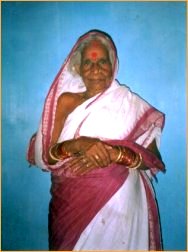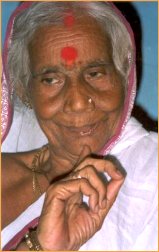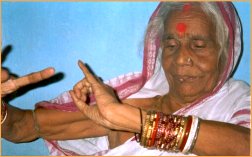
|
 |

|
 |
From the mouth of a Mahari - Rahul Acharya, Bhubaneswar Photos by Rahul Acharya e-mail: rahul_acharya@rediffmail.com December 24, 2003 (Rahul Acharya visits Sashimani Mahari, the last surviving devadasi of the Jagannath temple, Puri. The article is a discussion with her.)  The dance of the Mahari was said to be a treat for the eye. Her Bhramaris (rotational movements) to the tune of 'Tham Thei' of the Thai Nata or her portrayal of the erotic sentiments to the 'Kuru Yadu Nandana' of the Geeta Govinda were unforgettable incidents for a spectator who had viewed them even once in his lifetime. It is said that their dance used to captivate the great Lord himself, not to speak of ordinary human beings and thus they were referred to as Maharis or great ladies, who had the power to enchant the Lord himself. A legend goes that Lord Jagannath once accompanied a beautiful Mahari to her garden, who was humming 'Chandana Charchita' (another song from the Geeta Govinda) while plucking Tulsi leaves. In the great temple, thorns were found sticking to his royal attire. Such was the aura of a Mahari whose eye-lashes constituted the very essence of captivating the whole world, whose very gait brought about a complete stillness in the activities of the three worlds, whose bangles bejeweled with precious stones served as an unarranged candle during the dance, that these deer-eyed maidens were offered in devotion to Lord Jagannath. Everything seems to have ended abruptly without any logical explanation for its sudden demise. No longer are the Ghungroos (ankle-bells) heard nor do the drums play. There is seldom any recitation of the Geeta Govinda inside the great temple, which still boasts to be the birthplace of the modern Odissi dance. Curtains will be drawn on the grandeur of the Mahari tradition after the death of the last two surviving ones: Sashimani and Parashmani, who have-not left any successor. It is doubtful whether the next generation will be able to know anything about them. The Mahari seva (service) was once an integral part of the daily Nitis (rituals) conducted in the Jagannath temple. Many researchers have given varied opinions about its inception as a seva in the temple. But the fact is that it started from the day of installation of the temple deities. This aforementioned argument is further proven in the "Niladri Mahodaya" (text in which the temple rituals are enshrined) where Lord Brahma instructs King Indradyumna about the mode of worship: Ghanta mardalayorabaha pujayam prtyaham nrupa Pujabasanaparyanta mebam syanrutyagitake (N.M, Chap: 7, Sh:117) Oh king! During the ritual proceedings, daily, there should be arrangement for the playing of the Ghanta (brass-plate instrument), Mardala (percussion) and dance. This should continue till the Puja (worship) is over. Another shloka mentions about the performance of dance and music during the 'Bada Shingara' (night or bedtime) rituals: Malyoratulyarachanairvesham kuryanmanoharam Gite nrutya cha purato jayamane muhurmuhu (N.M, Chap: 8, Sh:49) The arrangement for a performance of dance and music is a must when the Lord is being adorned with garlands. The Record of rights (government chronicle on the rituals of the Jagannath temple) specifies the exact proceedings of the Bhitara Gauni seva (service of the inner musician): Alati samayare bhitara gauni (mahari) kalahata duare jagannathanka parsware basi gana kariba 
During the Arati (waving of lamps), the Bhitara Gauni or Mahari is supposed to sit at the Kalahata Dwara (a door of the main temple) towards the side of Lord Jagannath and render her voice for praising the supreme Lord. This service continued until recent days. These ladies never married, but devoted themselves to the Lord, in temple service. It is said that the Mahari never saw the light of the sun. This meant that she never danced outside the temple, in public gatherings. She was only meant to entertain the Lord. Now when we read about the past history, as Odissi dancers, it is a pity to say that there is nothing left to retrospect. There is no one to guide us correctly. Whatever is said or heard about this tradition is nothing more than textual. It is hard to realize that this pristine culture is no more. The following is an account of my discussion with Sashimani Mahari. It is a narrative experience of Sashimani's yesteryears and about the Mahari rituals. It is a step to let my readers know about the true life of a Mahari in her words. In the words of Sashimani: "Those days, it was a norm to choose either Brahmin, Karana, or Khandayat girls as Maharis. The process of choosing was a very elaborate one and we were chosen strictly based upon our beauty. This was done to ensure that our beauty appealed to the Lord, as after we became Maharis we were not ordinary mortal ladies but were supposed to be great ladies. I was born to Suryamani Mahari, who was the sister of Harapriya Mahari, at Markandeswara Sahi (a locality of Puri). I never knew who my father was. As far as I can recollect, I have never seen a male in our locality. We were brought up amongst ladies only. I remember having started my dance lessons as a toddler at the tender age of three, under the guidance of my mother and Sri Mohan Mohapatra. We never had any strict grammar for dance. All lessons were quite spontaneous and we were supposed to feel the dance rather than doing it mechanically. My dancing lessons continued till the age of seven and then I was ready to enter the great temple to begin my seva. An auspicious day was fixed for my marriage with the Lord (according to Sashimani, they were married to the Lord). The ritual was called "Sadi Bandana" (tying of saree). That day was of great enjoyment for us as it was the only day we were allowed to socialize. After this day, we were not supposed to see any male's face. In the morning, on the said day, I was given a grand bath with sandalwood paste, turmeric and scented water and was dressed with 'Pata sarani' (indigenous silk saree) and the best of the gold ornaments we had. I was then taken to our local Brundabati Chaura (Tulsi altar) with a handful of rice topped with a betel nut. The whole day I was on complete fast even without a drop of water. There, at the altar, our Kulaguru (family priest) gave me dikshya (initiation). After the ceremony, I was carried to the temple in a procession. There, inside the temple I stood at the Jaya Bijaya Dwara (another door of the main temple) where the saree was tied on my head. The Pattajoshi Mohapatra (a servant of the Lord) then garlanded me with the Lord's flowers. Then a Ramanandi Chita (Vaishnavite mark) and a Sindura topa (vermillion spot) were painted on my forehead. This was to show that I was married to the Lord. After this, I went round the temple seven times, as a married woman does around the fire altar.  After the temple ceremony, all returned to my house where we were entertained with Mahaprasada (food offered to Lord Jagannath). In the evening I was taken to the Sri Nahara (royal palace) to perform the Palanka- seva (cot rituals), which consisted of singing before the king's bed. There I sat singing, looking directly into the king's eye. This part of the ritual in the palace was observed as the Gajapati Maharaj (king) of Puri is venerated as the moving image of Lord Jagannath. Though we were married to the Lord, we were supposed to remain spinsters all our lives, i.e. we were not allowed to accept any mortal husbands. Those who did were debarred from seva. The next day was my first day of service. I was given a purificatory bath, dressed with elaborate costumes and brought to the temple. Those days we wore only gold, however, modern Odissi dancers can afford only silver ornaments. This performance was during the Sakala dhupa (breakfast) and I performed to the accompaniment of Mardala (percussion) and gini (cymbals), quite oblivious of the surrounding. The Rajguru (royal priest) was monitoring me with a golden stick in his hand. The dance was a Nritta (pure dance) without any song accompanying it. The second performance took place during Bada Shingara and this was performed under closed doors. During this time the dance was supposed to be expressional and the songs accompanying the dance were taken from the Geeta Govinda alone. This service continued each day, each month and each year. As far as I remember, I never terminated my performance even for a single day. I never fell ill and enjoyed performing for the Lord. Each day was a divine experience for me and I used to become ecstatic during my performances. I considered myself blessed as I was also receiving guidance from none other than Kokilaprava Mahari who was then serving as a Bhitara Gauni. Dance as a ritual was also performed in front of Goddess Vimala in the main temple and Goddess Kanaka Durga in the Sri Nahara on the Mahashtami (eighth day of the Durga puja) day, in the evening. This service of mine continued for forty long years. All I used to get was twenty-five paise as 'khei' (salary) and a lot of divine love. I wanted nothing more. Those days we were a respectable community and were treated as goddesses. But this did not continue for long. Slowly we were suspected to be associated with Ganikas (prostitutes). This gave rise to a rebellion inside the temple. Little did we realize that this was the beginning of an end. All those people who respected us started despising us. Only my Lord knows what the truth was. Finally the rebellion became so strong that everything was stopped. Dance as a ritual was completely terminated and music became an optional ritual. Thirty years have passed since then. No one is alive. Only Parashmani and I are surviving. I have nothing to do but to stare at the Lord all day. Now I am too old and even though I feel energetic, my body has become so feeble that it no more permits me to dance. I am still receiving a khei of one hundred and fifty rupees per month. As part of my service I am doing the Nandotsav seva (the day after Janmashtami), which is part of the Samprada nijog seva (outer ceremonial rites), that comes once a year. I still survive and am pulling on just because of my great Lord."  Author's note: On the day of my visit, Sashimani was kind enough to show me a bit of her dance. Being an Odissi dancer myself, I was stupefied by her wondrous grace that she maintains even at this age (she is nearing ninety). She permitted me to take a few photographs of her, during her performance. From the age of 4, Rahul Acharya has been a student of guru Durga Charan Ranbir. He is an empanelled artist of Indian Council for Cultural Relations (ICCR) since March 2003, and an honorary member of Sacred Dance Guild, USA. He is involved in research in Jagannath Culture and is studying M. Sc. in Biotechnology. He is a regular contributor to narthaki.com. |